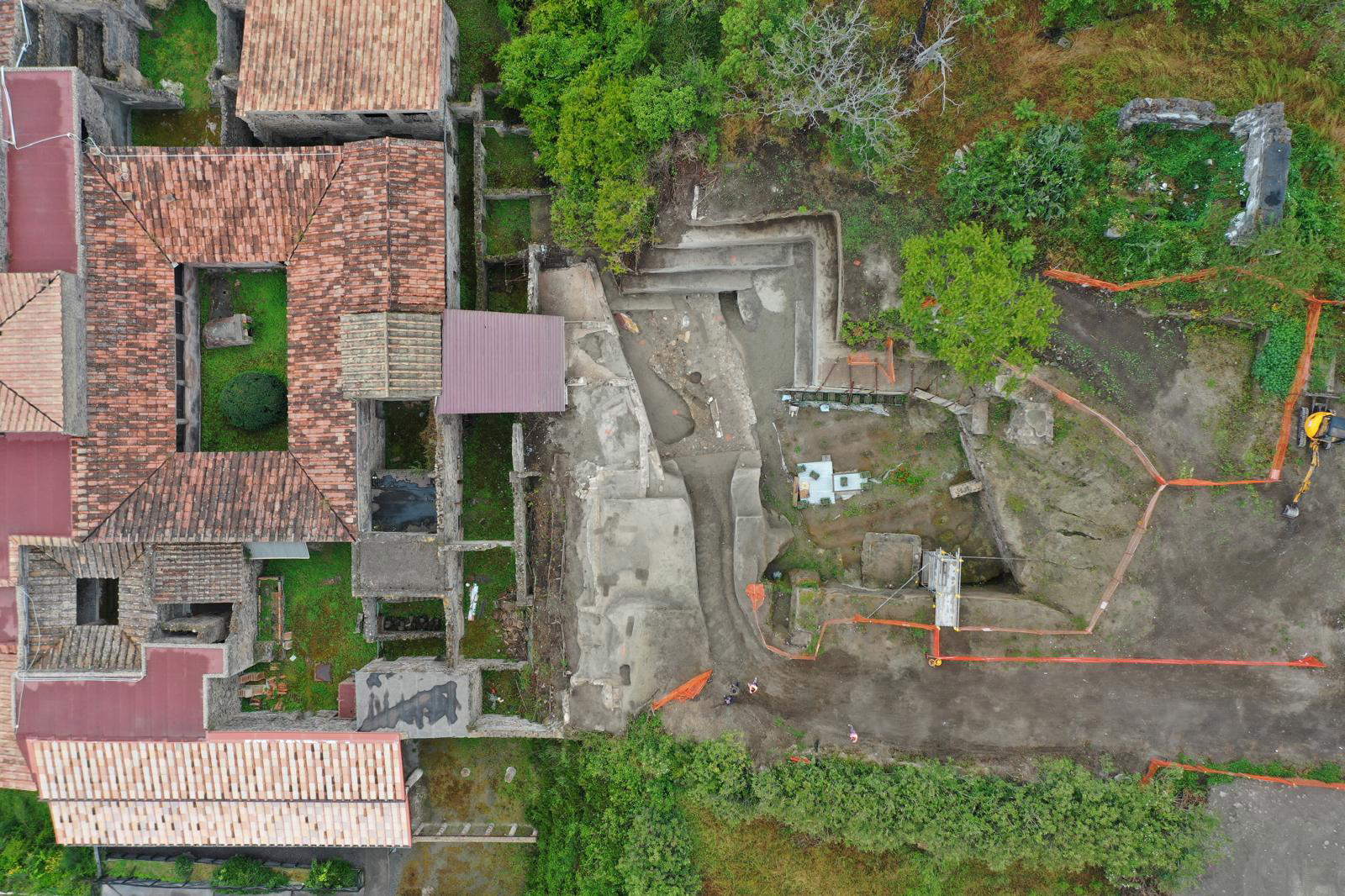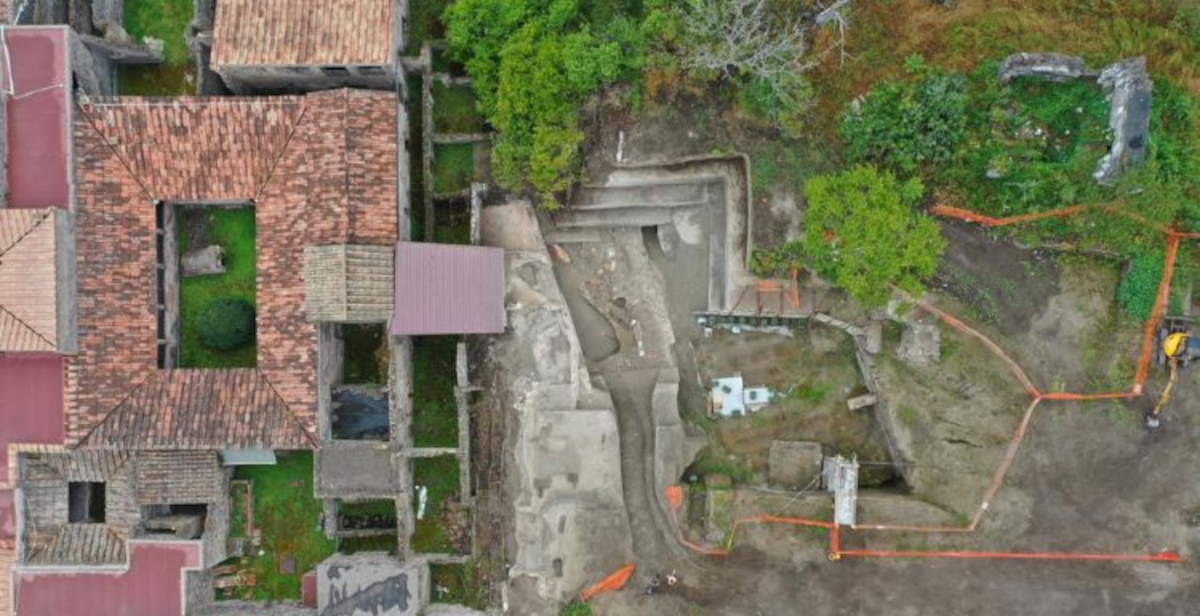Recent archaeological investigations in Pompeii have uncovered a find that presents new insights into social and daily life in the ancient Vesuvian city. In the northwestern area of the Villa of the Mysteries, one of the site’s best-known residential complexes, a cocciopesto bench was found placed on the public street, right in front of the villa’s monumental entrance. The find suggests a use related to waiting for customers, laborers and beggars who paused in front of the gateway, in a context that in some respects approximates a modern waiting room.
Comparison with Roman social dynamics allows us to hypothesize that the bench was intended for the clientes of the villa owner, figures of lower social rank who, according to the custom of salutatio, went to their patron in the morning. In exchange for political support and social visibility, the master granted them favors, help in legal matters, and sometimes loans. The presence of an outdoor bench could thus be a tangible sign of the dominus’ prestige: the greater the number of people waiting, the greater the owner’s influence on the civic and political fabric of the city. Similar phenomena are found in front of other Pompeian domus, where similar structures served a practical and symbolic function.

“During the long hours of waiting, you often did not know if the master would receive you that day,” explains Pompeii’s director Gabriel Zuchtriegel, “maybe he had had a late night the night before and preferred to sleep, or he had something else to do. Then someone waiting here, with a sharp object or a piece of coal wrote on the wall to pass the time: you can read a date, though without a year, and a possible name. It is, so to speak, the other side of the wonderful frescoed rooms overlooking the gulf; who knows if the people waiting in front of the gate would have ever seen such a thing in their lives. To see today the villa visited daily by thousands of people from all over the world is beautiful: what was once a social privilege is now within everyone’s reach, mostly every first Sunday of the month totally free of charge.”
“The resumption of archaeological excavations in the Villa of the Mysteries,” says Torre Annunziata Public Prosecutor Nunzio Fragliasso, “was been possible thanks to the synergistic collaboration between the Archaeological Park of Pompeii and the Public Prosecutor’s Office of Torre Annunziata, in implementation of the protocols stipulated between the two institutions both in the area of combating illegal trafficking in archaeological finds and in the area of financing the demolition of illegal works carried out in the area subject to archaeological constraints under the jurisdiction of the Archaeological Park of Pompeii. By virtue of this collaboration, in addition to the demolition of the house subject to unauthorized works overhanging the Villa of the Mysteries, there has also been the demolition, financed with funds from the Archaeological Park, of an entirely unauthorized structure, intended for catering activities, located in the area in front of the Villa of the Mysteries, thus allowing better enjoyment of the site by visitors.”

The Villa of the Mysteries is best known for the Dionysian-Mystery-themed frescoes discovered in 1909-1910, which helped make it a landmark for studies of art and religiosity in the Roman world. In any case, the latest discoveries open a different perspective, linked less to the artistic dimension and more to the sphere of social and economic relations. Those who sat on that bench were in fact not curious visitors, like the many who still flock to the site’s most renowned domus, but rather individuals moved by the need for support or daily work along the road that connected Pompeii to the area that today corresponds to Boscoreale, and thus by concrete needs.
The discovery is part of the excavation and securing activities begun in the area, made possible in part by the demolition of an illegal building that overlooked the villa. The operation, carried out in agreement with the Public Prosecutor’s Office, had a twofold objective: on the one hand to document and counteract the clandestine excavation activity that has affected the area, and on the other to complete the investigations begun in the twentieth century by Amedeo Maiuri, then director of the excavations, bringing to light the still-buried parts of the complex.

The survey identified the monumental original entrance to the villa, facing the so-called Via Superior, with a large doorway surmounted by an arch, now only partially preserved, flanked by masonry paracarriers and the paved section of the lava stone road. Next to the cocciopesto bench, a rectangular vaulted cistern emerged, connected to a water system intended for water collection and regulation, confirming the complex architectural and functional organization of the complex.
Inside the villa, archaeologists uncovered rooms decorated in the third Pompeian style, characterized by black and yellow backgrounds with high-quality ornamental motifs. Still-buried portions of the servile quarters were also identified, the exploration of which is bound to expand knowledge of the structure and its organization. The excavation also offered a precise stratigraphic record of the AD 79 eruption, with the sequence of fall pumice deposits and pyroclastic flows that sealed the rooms. Below these levels, a portion of paleosol organized in conchettes, an agricultural technique used for land management in Roman times, has resurfaced.


The data collected outline a scenario in which the Villa of the Mysteries is confirmed as a place strongly embedded in the social and productive fabric of the time. The identification of the bench and other elements connected to the entrance allows for a deeper understanding of the relationship between the complex and the surrounding community, revealing the political and economic weight exerted by the owner and the network of relationships that gravitated around the villa. The continuation of the research aims to complete the excavation of the still uninvestigated parts, with particular attention to the servile quarter. The in-depth study will expand knowledge about the inner workings of the villa and the social dynamics related to its management, contributing to the enhancement of one of the best-known residential complexes of ancient Pompeii.
 |
| Pompeii, waiting bench discovered in front of the famous Villa of Mysteries |
Warning: the translation into English of the original Italian article was created using automatic tools. We undertake to review all articles, but we do not guarantee the total absence of inaccuracies in the translation due to the program. You can find the original by clicking on the ITA button. If you find any mistake,please contact us.